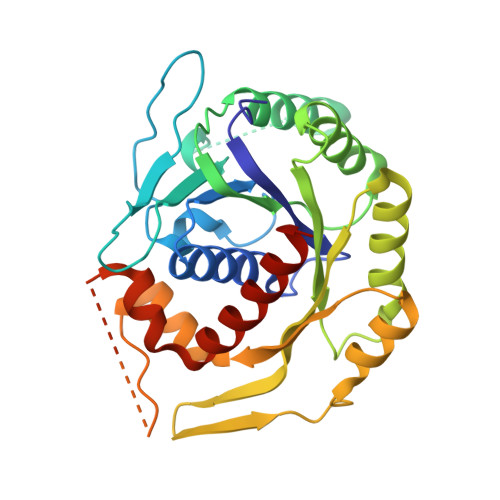Function and crystal structure of the dimeric P-loop ATPase CFD1 coordinating an exposed [4Fe-4S] cluster for transfer to apoproteins.
Stehling, O., Jeoung, J.H., Freibert, S.A., Paul, V.D., Banfer, S., Niggemeyer, B., Rosser, R., Dobbek, H., Lill, R.(2018) Proc Natl Acad Sci U S A 115: E9085-E9094
- PubMed: 30201724
- DOI: https://doi.org/10.1073/pnas.1807762115
- Primary Citation of Related Structures:
6G2G - PubMed Abstract:
Maturation of iron-sulfur (Fe-S) proteins in eukaryotes requires complex machineries in mitochondria and cytosol. Initially, Fe-S clusters are assembled on dedicated scaffold proteins and then are trafficked to target apoproteins. Within the cytosolic Fe-S protein assembly (CIA) machinery, the conserved P-loop nucleoside triphosphatase Nbp35 performs a scaffold function. In yeast, Nbp35 cooperates with the related Cfd1, which is evolutionary less conserved and is absent in plants. Here, we investigated the potential scaffold function of human CFD1 (NUBP2) in CFD1-depleted HeLa cells by measuring Fe-S enzyme activities or 55 Fe incorporation into Fe-S target proteins. We show that CFD1, in complex with NBP35 (NUBP1), performs a crucial role in the maturation of all tested cytosolic and nuclear Fe-S proteins, including essential ones involved in protein translation and DNA maintenance. CFD1 also matures iron regulatory protein 1 and thus is critical for cellular iron homeostasis. To better understand the scaffold function of CFD1-NBP35, we resolved the crystal structure of Chaetomium thermophilum holo-Cfd1 (ctCfd1) at 2.6-Å resolution as a model Cfd1 protein. Importantly, two ctCfd1 monomers coordinate a bridging [4Fe-4S] cluster via two conserved cysteine residues. The surface-exposed topology of the cluster is ideally suited for both de novo assembly and facile transfer to Fe-S apoproteins mediated by other CIA factors. ctCfd1 specifically interacted with ATP, which presumably associates with a pocket near the Cfd1 dimer interface formed by the conserved Walker motif. In contrast, ctNbp35 preferentially bound GTP, implying differential regulation of the two fungal scaffold components during Fe-S cluster assembly and/or release.
Organizational Affiliation:
Institut für Zytobiologie und Zytopathologie, Philipps-Universität Marburg, 35033 Marburg, Germany.
















